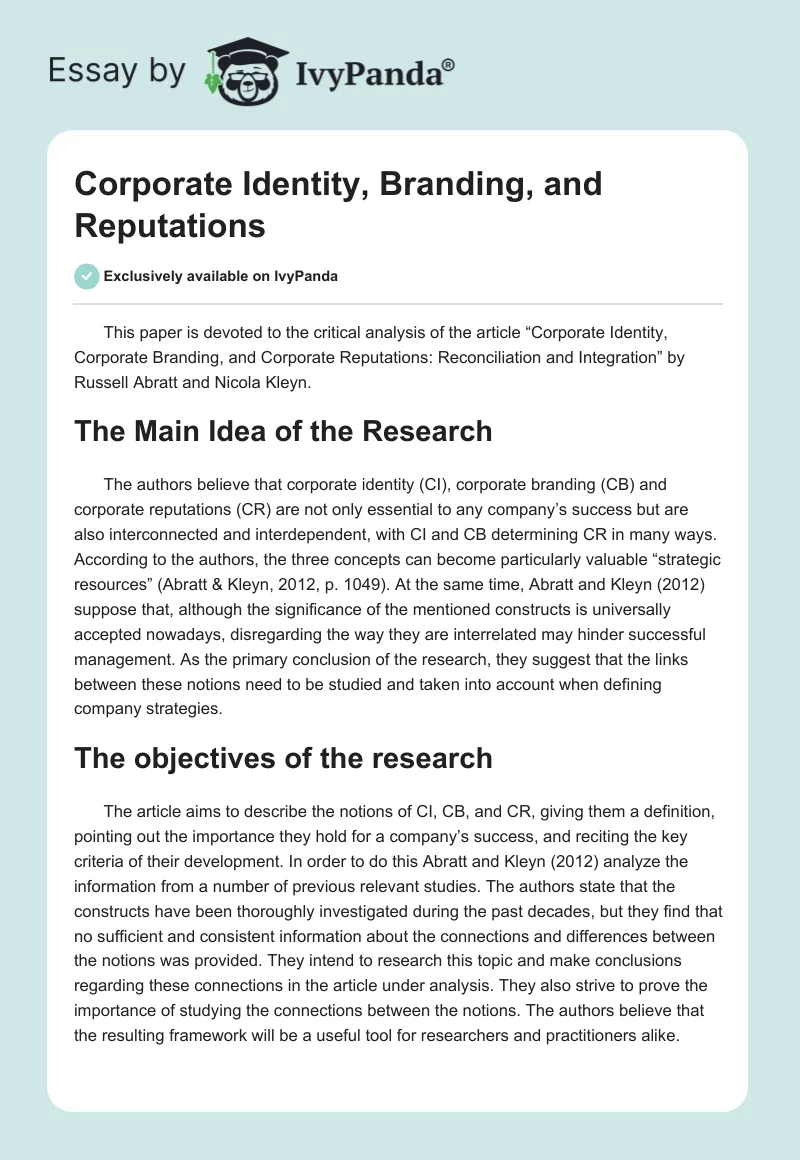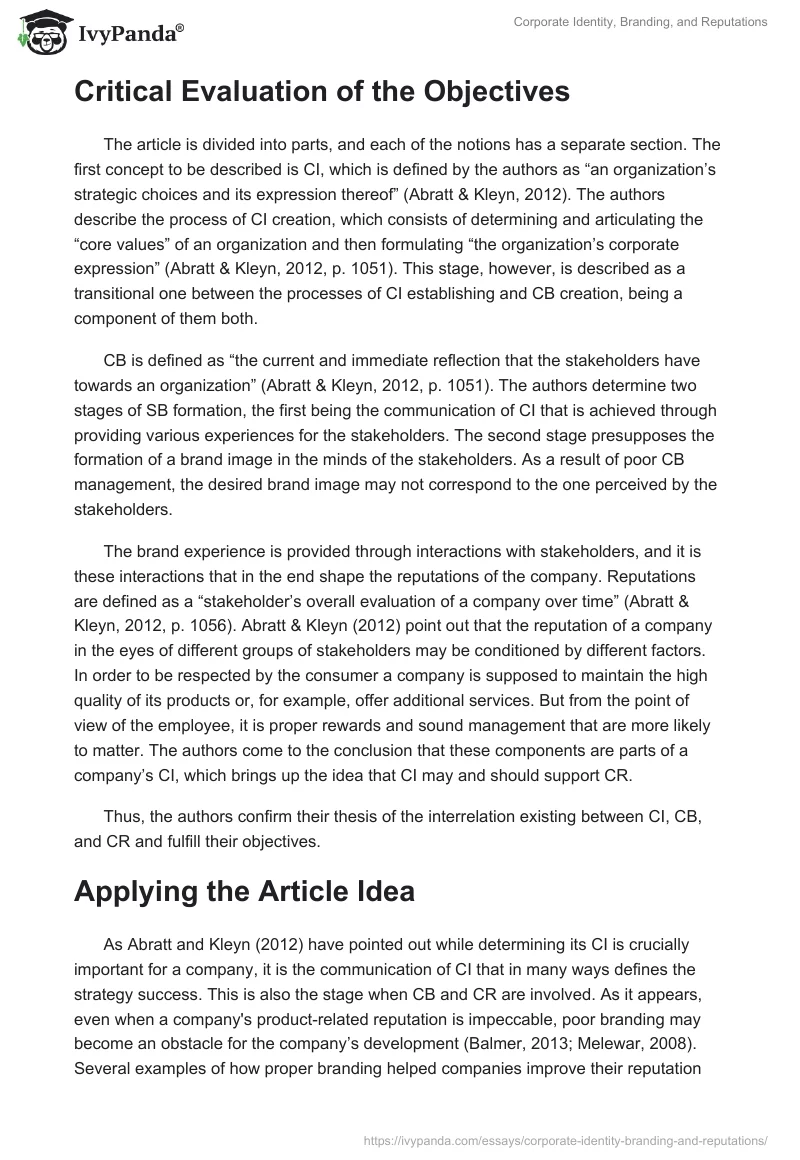This paper is devoted to the critical analysis of the article “Corporate Identity, Corporate Branding, and Corporate Reputations: Reconciliation and Integration” by Russell Abratt and Nicola Kleyn.
The Main Idea of the Research
The authors believe that corporate identity (CI), corporate branding (CB) and corporate reputations (CR) are not only essential to any company’s success but are also interconnected and interdependent, with CI and CB determining CR in many ways. According to the authors, the three concepts can become particularly valuable “strategic resources” (Abratt & Kleyn, 2012, p. 1049). At the same time, Abratt and Kleyn (2012) suppose that, although the significance of the mentioned constructs is universally accepted nowadays, disregarding the way they are interrelated may hinder successful management. As the primary conclusion of the research, they suggest that the links between these notions need to be studied and taken into account when defining company strategies.
The objectives of the research
The article aims to describe the notions of CI, CB, and CR, giving them a definition, pointing out the importance they hold for a company’s success, and reciting the key criteria of their development. In order to do this Abratt and Kleyn (2012) analyze the information from a number of previous relevant studies. The authors state that the constructs have been thoroughly investigated during the past decades, but they find that no sufficient and consistent information about the connections and differences between the notions was provided. They intend to research this topic and make conclusions regarding these connections in the article under analysis. They also strive to prove the importance of studying the connections between the notions. The authors believe that the resulting framework will be a useful tool for researchers and practitioners alike.
Critical Evaluation of the Objectives
The article is divided into parts, and each of the notions has a separate section. The first concept to be described is CI, which is defined by the authors as “an organization’s strategic choices and its expression thereof” (Abratt & Kleyn, 2012). The authors describe the process of CI creation, which consists of determining and articulating the “core values” of an organization and then formulating “the organization’s corporate expression” (Abratt & Kleyn, 2012, p. 1051). This stage, however, is described as a transitional one between the processes of CI establishing and CB creation, being a component of them both.
CB is defined as “the current and immediate reflection that the stakeholders have towards an organization” (Abratt & Kleyn, 2012, p. 1051). The authors determine two stages of SB formation, the first being the communication of CI that is achieved through providing various experiences for the stakeholders. The second stage presupposes the formation of a brand image in the minds of the stakeholders. As a result of poor CB management, the desired brand image may not correspond to the one perceived by the stakeholders.
The brand experience is provided through interactions with stakeholders, and it is these interactions that in the end shape the reputations of the company. Reputations are defined as a “stakeholder’s overall evaluation of a company over time” (Abratt & Kleyn, 2012, p. 1056). Abratt & Kleyn (2012) point out that the reputation of a company in the eyes of different groups of stakeholders may be conditioned by different factors. In order to be respected by the consumer a company is supposed to maintain the high quality of its products or, for example, offer additional services. But from the point of view of the employee, it is proper rewards and sound management that are more likely to matter. The authors come to the conclusion that these components are parts of a company’s CI, which brings up the idea that CI may and should support CR.
Thus, the authors confirm their thesis of the interrelation existing between CI, CB, and CR and fulfill their objectives.
Applying the Article Idea
As Abratt and Kleyn (2012) have pointed out while determining its CI is crucially important for a company, it is the communication of CI that in many ways defines the strategy success. This is also the stage when CB and CR are involved. As it appears, even when a company’s product-related reputation is impeccable, poor branding may become an obstacle for the company’s development (Balmer, 2013; Melewar, 2008). Several examples of how proper branding helped companies improve their reputation and increase their profit are shown in the book “Designing corporate identity” (Knapp, 2001).
Other constituents of success should also be taken into account. For instance, a couple of words could be said about fashion. A company must be flexible and sensitive to the changes in the market and in the world, and it is obvious that the notion of fashion may also refer to the field of strategies and techniques. Adopting such fashionable trends, for example, corporate social responsibility (CSR) may serve to increase CR. The concept of CSR presupposes taking into account the impact a company has on society and the environment (Vallaster, Lindgreen & Maon, 2012). Upon including this new aspect into its CI, a company should seek to communicate this to its stakeholders which will influence both its CB and CR.
Flexibility reasons also suggest that, although the core components of CI are supposed to be stable, it may be useful to change the signs expressing it, which has been done by business long-livers like the Coca-Cola Company (Podnar, 2014). Their success illustrates the constituency of this idea that presupposes the expression of an important point of CI (the idea of constant modernization) through CB (the creation of a new image), which has a positive impact on the company’s CR.
Summary of the Article
In their article Abratt and Kleyn (2012) carry out research of the notions of CI, CB, and CR after thoroughly analyzing the previous works devoted to these constructs and then provide their own ideas and conclusions, supporting them with sound arguments. They manage to prove their idea about the interrelation existing between the constructs, demonstrating how CI and CB are used to determine and maintain CR and each other. The authors also dwell on the significance of the constructs and the impact they have on the company’s development and performance. Finally, they prove that it is the combination of all three concepts that may pave the road to success.
The authors also point out that further investigation in this direction could be appreciated, particularly when CB is concerned.
Recommendations
Due to the constituency of the arguments of Abratt and Kleyn (2012), the importance of the integral view of the three constructs does not cause doubts, and it is obvious that this approach may be particularly helpful. It also appears that it should be implemented in real-life management processes when possible. Unfortunately, certain topics were not described or sufficiently developed by the authors of the article since their objectives did not include dwelling on those topics. As Abratt and Kleyn (2012) have pointed out themselves, further research on the development of CB is supposed to be carried out in the future. Besides, it is not less important to continue to discuss the rest of the constructs described in the article. To research and describe the numerous constituents of CR that were mentioned, but not dwelled upon by Abratt and Kleyn (2012) could be both interesting and helpful.
References
Abratt, R., & Kleyn, N. (2012). Corporate identity, corporate branding and corporate reputations. European Journal of Marketing, 46(7/8), 1048-1063.
Balmer, J. (2013). Weathervanes or Signposts? Constructs or Philosophy?. In K. Podnar & J. Balmer (Eds.), Contemplating Corporate Marketing, Identity and Communication (pp. 3-36). London, UK: Routledge.
Knapp, P. (2001). Designing corporate identity. Gloucester, Mass.: Rockport.
Melewar, T. (2008). Facets of corporate identity, communication, and reputation. Abingdon, UK: Routledge.
Podnar, K. (2014). Corporate communication. London, UK: Routledge.
Vallaster, C., Lindgreen, A., & Maon, F. (2012). Strategically Leveraging Corporate Social Responsibility: A Corporate Branding Perspective. California Management Review, 54(3), 34-60.


